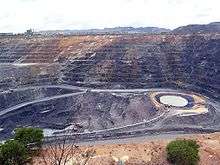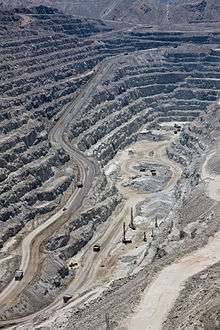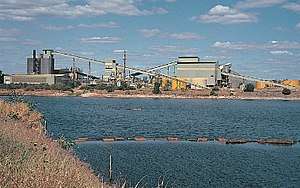Uranium mining debate
The uranium mining debate covers the political and environmental controversies of the mining of uranium for use in either nuclear power or nuclear weapons.


Background
As of 2009, in terms of uranium production, Kazakhstan was the largest supplier to export markets (27%), followed by Canada (20%) and Australia (16%).[1] Australia has 23% of the world's uranium ore reserves[2] and the world's largest single uranium deposit, located at the Olympic Dam Mine in South Australia.[3]
The years 1976 and 1977 saw uranium mining become a major political issue in Australia, with the Ranger Inquiry (Fox) report opening up a public debate about uranium mining.[4] The Movement Against Uranium Mining group was formed in 1976, and many protests and demonstrations against uranium mining were held.[4][5] Concerns relate to the health risks and environmental damage from uranium mining.
In 1977, the National Conference of the Australian Labor Party (ALP) passed a motion in favour of an indefinite moratorium on uranium mining, and the anti-nuclear movement in Australia acted to support the Labor Party and help it regain office. However, after the ALP won power in 1983, the 1984 ALP conference voted in favour of a "Three mine policy".[6]
Australia has three operating uranium mines at Olympic Dam (Roxby) and Beverley - both in South Australia's north - and at Ranger in the Northern Territory. As of April 2009, construction has begun on South Australia's fourth uranium mine—the Honeymoon Uranium Mine.[7]
The Rössing Uranium Mine located in Namibia is the world's longest-operating open-pit uranium mine. The uranium mill tailings dam has been leaking for a number of years, and on January 17, 2014, a catastrophic structural failure of a leach tank caused a major spill.[8] The France-based laboratory, Commission de Recherche et d'Information Independentantes sur la Radioactivite (CRIIAD) reported elevated levels of radioactive materials in the area surrounding the mine.[9][10]
Notable anti-uranium activists include Golden Misabiko (Democratic Republic of the Congo)[11][12], Kevin Buzzacott (Australia), Jacqui Katona (Australia), Yvonne Margarula (Australia), Jillian Marsh (Australia), Manuel Pino (US), JoAnn Tall (US), and Sun Xiaodi (China).[13][14][15] There have been many reports about working conditions at the mine, and the effects on the mine laborers.[16]
Health risks of uranium mining
Because uranium ore emits radon gas, uranium mining can be more dangerous than other underground mining, unless adequate ventilation systems are installed. During the 1950s, many Navajos in the U.S. became uranium miners, as many uranium deposits were discovered on Navajo reservations. A statistically significant subset of these early miners later developed small cell carcinoma after exposure to uranium ore.[17] Radon-222, a natural decay product of uranium, has been shown to be the cancer-causing agent.[18] Some American survivors and their descendants have received compensation under the Radiation Exposure Compensation Act which was enacted in 1990, and as of 2016 continues to receive and award claims. Successful claimants have include uranium miners, mill workers and ore transporters.
Residues from processing of uranium ore can also be a source of Radon. Radon resulting from the high radium content in uncovered dumps and tailing ponds can be easily released into the atmosphere. [19]
Also possible is the contamination of ground water and surface water with uranium by leaching processes. In July 2011, the World Health Organization (WHO) released the fourth edition of its guidelines for drinking-water quality. The drinking water guidance level for uranium was increased to 30 μg/L. This limit can be exceeded near mill tailings or mining sites.[20]
In January 2008 Areva was nominated for an Anti Oscar Award.[21] The French state-owned company mines uranium in northern Niger where mine workers are not informed about health risks, and analysis shows radioactive contamination of air, water and soil. The local organization that represents the mine workers spoke of "suspicious deaths among the workers, caused by radioactive dust and contaminated groundwater".[22]
Uranium mining and indigenous people
Large-scale uranium mining operations throughout the world have had a significant impact on indigenous peoples and their ways of life, raising questions concerning economic development of "remote regions" in relation to the impact on traditions life styles of these cultures, and resulting health and environmental hazards.[23] The Jabiluka uranium mine is located in Kakadu National Park, Australia, is a World Heritage Site and home to the Mirrar Aboriginal culture. A dispute exists between the mining industry, the Mirrar people represented by Yvonne Margarula, ecologists and politicians on the implications of postcolonialism in relation to the impacts on the health and vitality of humans and other species, and effects on scarce water resources.[24][25] The impact of uranium mining, milling and processing for India's burgeoning nuclear power industry has created controversy between indigenous peoples and mining and energy development.[26] Winona LaDuke, spokesperson for Native Americans and First Nations has written extensively on the impact of uranium mining on indigenous communities.[27][28] The Jackpile Uranium Mine was the world's largest open-pit uranium mine until its closure in the 1980s. The mine, located on Laguna Pueblo land in New Mexico covered approximately 2,500 acres, and employed Laguna, Canyoncito, Acoma and Zuni Pueblo people, as well as the Navajo.[29][30]
See also
References
- "World Uranium Mining". World Nuclear Association. Retrieved 2009-07-24.
- "Supply of Uranium".
- "Uranium Mining and Processing in South Australia". South Australian Chamber of Mines and Energy. 2002. Archived from the original on 2012-01-06. Retrieved 2007-01-14.
- Bauer, Martin (ed) (1995). Resistance to New Technology, Cambridge University Press, p. 173.
- Drew Hutton and Libby Connors, (1999). A History of the Australian Environmental Movement, Cambridge University Press.
- Burgmann, Verity (2003). Power, Profit and Protest pp. 174-175. Retrieved 8 December 2009.
- Work begins on Honeymoon uranium mine ABC News, April 24, 2009. Retrieved 8 February 2010.
- WISE Uranium Project. "Issues at Rössing Uranium Mine, Namibia". World Information Service on Energy, Uranium Project. Retrieved 7 April 2014.
- Commission de Recherche et d’Information Indépendantes sur la Radioactivité. "Preliminary results of CRIIRAD radiation monitoring near uranium mines in Namibia" (PDF). April 11, 2012. CRIIAD. Retrieved 7 April 2014.
- Commission de Recherche et d’Information Indépendantes sur la Radioactivité. "CRIIRAD Preliminary Report No. 12-32b Preliminary results of radiation monitoring near uranium mines in Namibia" (PDF). April 5, 2012. CRIIRAD EJOLT Project. Retrieved 7 April 2014.
- Gunter, Linda Pentz (2018-07-09). "Imprisoned, poisoned, tortured". Beyon Nuclear International. beyondnuclearinternational. Retrieved 31 August 2018.
- "Uranium Mining in the DR Congo" (PDF). nuclear-risks.org. Ecumenical Network Central Africa. Retrieved 31 August 2018.
- Phil Mercer. Aborigines count cost of mine BBC News, 25 May 2004.
- Anti-uranium demos in Australia BBC World Service, 5 April 1998.
- Jennifer Thompson. Anti-nuke protests Archived 2016-01-28 at the Wayback Machine Green Left Weekly, 16 July 1997.
- SOMO (2009-05-12). "Uranium workers Namibia unaware of severe health risks". May 12, 2009. SOMO, Netherlands. Retrieved 7 April 2014.
- Gottlieb, LS; LA Husen (1982-04-01). "Lung cancer among Navajo uranium miners". Chest. 81 (4): 449–452. doi:10.1378/chest.81.4.449. PMID 6279361. Retrieved 2007-08-09.
- Harley, Naomi; Ernest Foulkes; Lee H. Hilborne; Arlene Hudson; C. Ross Anthony (1999). "Chapter 2: Health Effects". A Review of the Scientific Literature As It Pertains to Gulf War Illnesses. RAND Corporation. pp. Volume 7: Depleted Uranium. Archived from the original on 2008-06-04. Retrieved 2008-05-10.
- P. Zoriy; M. Schläger; K. Murtazaev; J. Pillath; M. Zoriy; B. Heuel-Fabianek (2016). "Radon exhalation of the uranium tailings dump Digmai, Tajikistan". Journal of Environmental Radioactivity. 181: 109–117. doi:10.1016/j.jenvrad.2017.11.010. PMID 29136519. Archived from the original on 2008-06-04.
- Schläger, Martin; K. Murtazaev; B. Rakhmatuloev; P. Zoriy; B. Heuel-Fabianek (2016). "Monitoring of uranium concentrations in water samples collected near potentially hazardous objects in North-West Tajikistan". Radiation and Applications. International Union of Radioecology: 222–228. doi:10.21175/RadJ.2016.03.041.
- Aldred, Jessica (January 22, 2008). "Awards shine spotlight on big business green record". The Guardian. Retrieved May 10, 2008.
- "Public Eye Denounces Areva and Glencore, Praises Hess Natur" (PDF). The Guardian. January 23, 2008. Retrieved May 10, 2008.
- O'Faircheallaigh, Ciaran (March 1988). "Resource development and inequality in indigenous societies". World Development. 26 (3): 381–394. doi:10.1016/s0305-750x(97)10060-2.
- Banerjee, Suhabrata Bobby (March 2000). "Whose Land Is It Anyway? National Interest, Indigenous Stakeholders, and Colonial Discourses The Case of the Jabiluka Uranium Mine". Organization & Environment. RMIT University. 13 (1): 3–38. doi:10.1177/1086026600131001.
- "Environmental Justice Case Study: The Jabiluka Mine and Aboriginal Land Rights in Australia's Northern Territory". University of Michigan. Retrieved 19 February 2014.
- Karlsson, BG (August 22–28, 2009). "Nuclear lives: Uranium Mining, indigenous peoples, and Development in India". Economic and Political Weekly. 44 (34): 43–49. JSTOR 25663470.
- LaDuke, Winona (January–February 2009). "Uranium Mining, Native Resistance, and the Greener Path". Orion Magazine. Retrieved 19 February 2014.
- "Uranium Mining and Milling". WISE Uranium Project: World Information Service on Energy. Retrieved 19 February 2014.
- "Laguna Pueblo Indian Reservation Case Study: Jackpile-Paguate Mine, New Mexico". MiningWatch Canada. 28 January 2007. Archived from the original on 25 February 2014. Retrieved 19 February 2014.
- Frosch, Dan (19 February 2014). "Nestled Amid Toxic Waste, a Navajo Village Faces Losing its Land Forever". The New York Times. Retrieved 20 February 2014.
